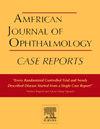Nd:YAG laser treatment for pupillary block secondary to toxic anterior segment syndrome after hole implantable collamer lens surgery
Q3 Medicine
引用次数: 0
Abstract
Purpose
To report the clinical course of pupillary block by fibrin in the central hole of an implantable collamer lens (ICL).
Observations
A 24 year old male with high myopia and astigmatism underwent EVO ICL (V5; STAAR Surgical, Monrovia, CA) implantation. The surgery was completed without any complications. The following day, the patient complained of blurry vision in the right eye and headache. The decimal uncorrected distance visual acuity was 1.5 in both eyes. Slit-lamp examination of the right eye revealed fibrin in the central hole of the ICL with a few cells in the anterior chamber. The intraocular pressure (IOP) and vault were increased to 33 mmHg and 1396 μm, respectively. A single shot of the Nd:YAG laser swept away the fibrin, and the reopening of the central hole was confirmed through the aqueous humor flow. The pupillary block was completely relieved 30 min later and the IOP and vault recovered to the normal range. One week postoperatively, the inflammatory reaction disappeared with topical eye drops including steroids. The uncorrected distance visual acuity was 1.5 in both eyes one year postoperatively. Ophthalmic examinations revealed unremarkable findings. We diagnosed the cause of the inflammatory reaction in the right eye as TASS because of the lack of severe pain in the eye, early occurrence, and favorable response to steroid therapy.
Conclusions and importance
Pupillary block by fibrin in the central hole may rarely occur following ICL implantation. In such cases, direct fibrin removal using Nd:YAG laser may be an effective treatment.
Nd:YAG激光治疗孔型人工晶状体术后毒性前段综合征继发瞳孔阻滞
目的报道纤维蛋白在人工晶状体中心孔瞳孔阻滞的临床过程。观察24岁男性,高度近视散光,行EVO ICL植入术(V5; STAAR Surgical, Monrovia, CA)。手术顺利完成,没有任何并发症。第二天,患者主诉右眼视力模糊,头痛。双眼未校正距离视力为1.5。右眼裂隙灯检查显示ICL中心孔可见纤维蛋白,前房可见少量细胞。眼压(IOP)和拱顶分别升高至33 mmHg和1396 μm。单次Nd:YAG激光扫去了纤维蛋白,通过房水流证实了中心孔的重新开放。30min后瞳孔阻滞完全解除,IOP和拱顶恢复到正常范围。术后1周,局部滴眼液(含类固醇)炎症反应消失。术后1年双眼未矫正距离视力为1.5。眼科检查无明显发现。我们诊断右眼炎症反应的原因是TASS,因为眼睛没有剧烈疼痛,发生早,并且对类固醇治疗有良好的反应。结论及重要性:ICL植入术后中心孔纤维蛋白引起的瞳孔阻滞极少发生。在这种情况下,使用Nd:YAG激光直接去除纤维蛋白可能是一种有效的治疗方法。
本文章由计算机程序翻译,如有差异,请以英文原文为准。
求助全文
约1分钟内获得全文
求助全文
来源期刊

American Journal of Ophthalmology Case Reports
Medicine-Ophthalmology
CiteScore
2.40
自引率
0.00%
发文量
513
审稿时长
16 weeks
期刊介绍:
The American Journal of Ophthalmology Case Reports is a peer-reviewed, scientific publication that welcomes the submission of original, previously unpublished case report manuscripts directed to ophthalmologists and visual science specialists. The cases shall be challenging and stimulating but shall also be presented in an educational format to engage the readers as if they are working alongside with the caring clinician scientists to manage the patients. Submissions shall be clear, concise, and well-documented reports. Brief reports and case series submissions on specific themes are also very welcome.
 求助内容:
求助内容: 应助结果提醒方式:
应助结果提醒方式:


